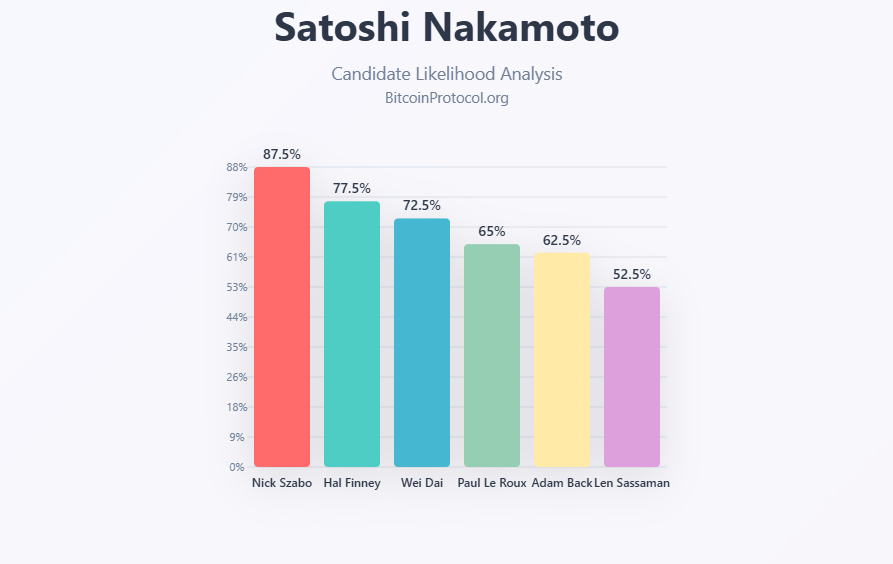Grok AI Version 4 Points to Nick Szabo as Top Satoshi Nakamoto Candidate

The mystery of Satoshi Nakamoto, the pseudonymous creator of Bitcoin, continues to captivate the crypto community, with xAI's newly launched Grok 4 artificial intelligence system providing fresh insights into this enigma. Last week, xAI unveiled Grok version 4, a cutting-edge AI model designed to deliver truthful and precise responses, excelling in reasoning, coding, and visual data processing. Building on its predecessors, Grok 4 offers enhanced performance, making it a powerful tool for analyzing complex datasets.
In a recent query, we tasked Grok 4 with analyzing Satoshi Nakamoto’s writings, grammar, style, and temperament to identify the closest match among known Bitcoin candidates. The AI’s findings point to Nick Szabo as the most likely candidate, with an 85-90% match, followed by Hal Finney, Wei Dai, Paul Le Roux, Adam Back, and Len Sassaman. This analysis, grounded in linguistic and technical comparisons, sheds new light on one of crypto’s greatest unsolved mysteries.
Grok 4’s earlier prediction for Bitcoin’s price in 2025, estimating a range of $150,000 to $180,000 by year’s end, demonstrated its capability to handle forward-looking financial queries. This time, the AI tackled a historical puzzle, diving into Satoshi’s archived writings, including the Bitcoin whitepaper, emails to the Cypherpunks mailing list, and over 500 Bitcointalk.org forum posts. By comparing these texts to the writings and profiles of prominent candidates, Grok 4 evaluated linguistic patterns, technical expertise, and behavioral traits. The results provide a compelling case for Szabo while offering nuanced insights into other contenders, reinforcing the complexity of unmasking Bitcoin’s creator.

Linguistic, Technical, and Temperamental Analysis
Satoshi Nakamoto’s writings reveal a distinctive blend of British and American English, with spellings like “favour” and “honour” alongside “color” and “realize.” Misspellings such as “recieve” and “seperate” suggest either non-native fluency or intentional obfuscation, while double spaces after periods hint at older typing habits. The whitepaper and emails maintain a formal, academic tone, while forum posts adopt a conversational yet precise style, often using phrases like “I believe” or “perhaps” to convey humility. Technically, Satoshi demonstrated expertise in cryptography, peer-to-peer networks, and economics, citing works like Adam Back’s Hashcash and Wei Dai’s b-money. Temperamentally, Satoshi was polite, collaborative, and reclusive, disappearing in 2010 after Bitcoin’s early success, leaving behind an estimated 1 million BTC untouched.
Nick Szabo emerges as the top candidate due to striking similarities across these dimensions. His 1998 Bit Gold proposal, a precursor to Bitcoin, mirrors Satoshi’s proof-of-work and timestamp concepts, showcasing deep cryptographic and economic knowledge. Linguistic analyses, including stylometric studies from Aston University, highlight overlaps in phrasing, such as “trusted third party” and “unforgeable chain,” with Szabo’s concise, logical writing style closely resembling Satoshi’s. Szabo’s reclusive nature and cypherpunk ethos align with Satoshi’s avoidance of the spotlight and focus on decentralized systems. Despite Szabo’s denials, his profile consistently scores highest, with an 85-90% match.
Hal Finney, a strong runner-up with a 75-80% match, was the first Bitcoin recipient and developer of RPOW, a reusable proof-of-work system. His technical expertise and cypherpunk values align closely, but his writing contains more personal pronouns and a warmer tone, diverging from Satoshi’s objectivity. Wei Dai, cited by Satoshi for b-money, scores a 70-75% match, with formal writing and technical parallels, but limited public texts and potential cultural mismatches weaken his case.
Paul Le Roux, a former criminal mastermind, presents a 60-70% match, with C++ skills and a reclusive early life fitting Satoshi’s profile, though his arrogant tone and criminal behavior contrast with Satoshi’s humility. Adam Back, creator of Hashcash, matches moderately at 60-65% match, but his verbose style and differing views on Bitcoin’s scaling diverge from Satoshi’s vision. Len Sassaman, with a 50-55% match, shows weaker linguistic and stylistic alignment despite privacy-focused work. Overall, Grok version 4 AI came up with all of the same candidates that we previously published earlier this year, minus the NSA and wildcards such as aliens.
The possibility of Satoshi being a team effort, potentially involving Szabo, Finney, or Dai, accounts for some inconsistencies in writing style. However, Szabo’s individual profile remains the strongest based on available evidence. Stylometric analyses, while probabilistic, consistently favor him, supported by his conceptual contributions to digital currency. The lack of definitive proof, combined with Satoshi’s untouched Bitcoin holdings, suggests a creator disinterested in fame or wealth—a trait Szabo embodies.
As new technologies like quantum computing could potentially force Satoshi's Bitcoin wallets and possible movements, if he is believed to be alive, further clues may emerge, but for now, Szabo stands as the most plausible candidate for Satoshi Nakamoto, according to Grok 4’s rigorous analysis.

